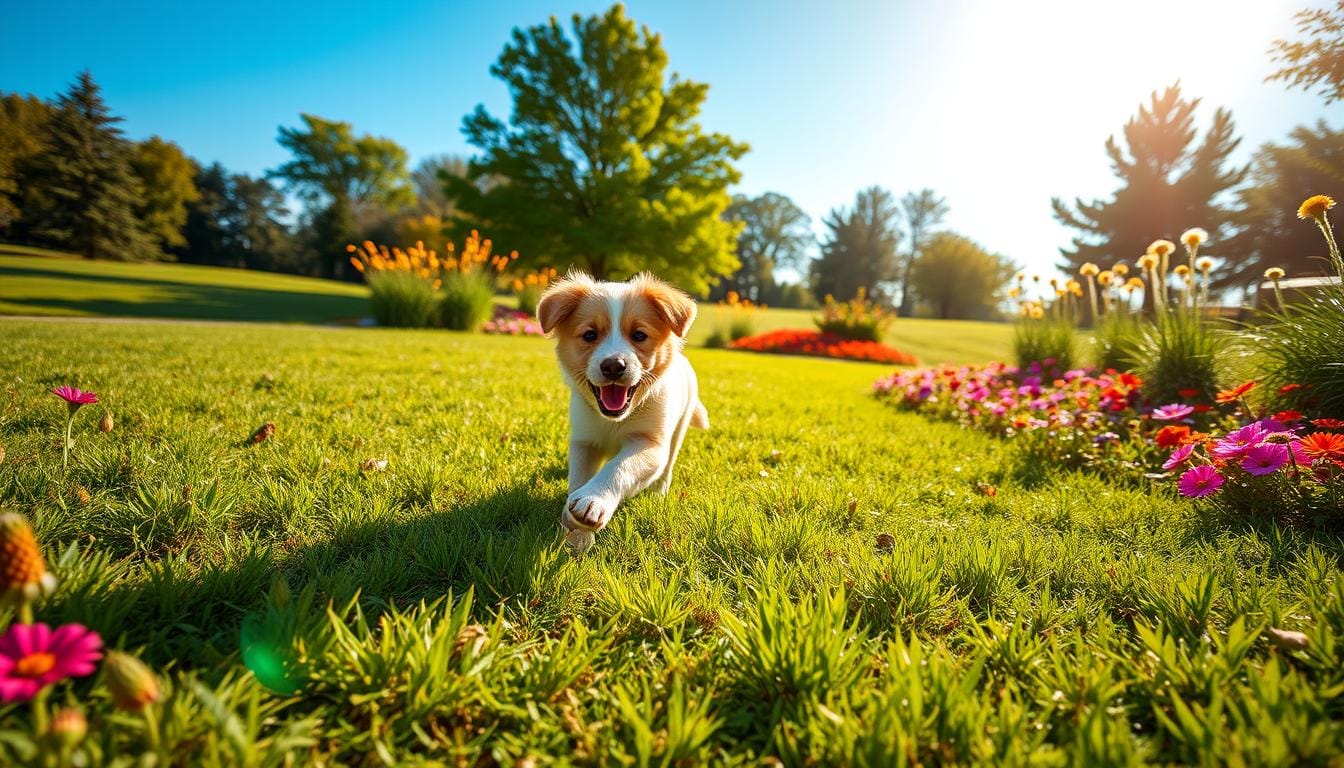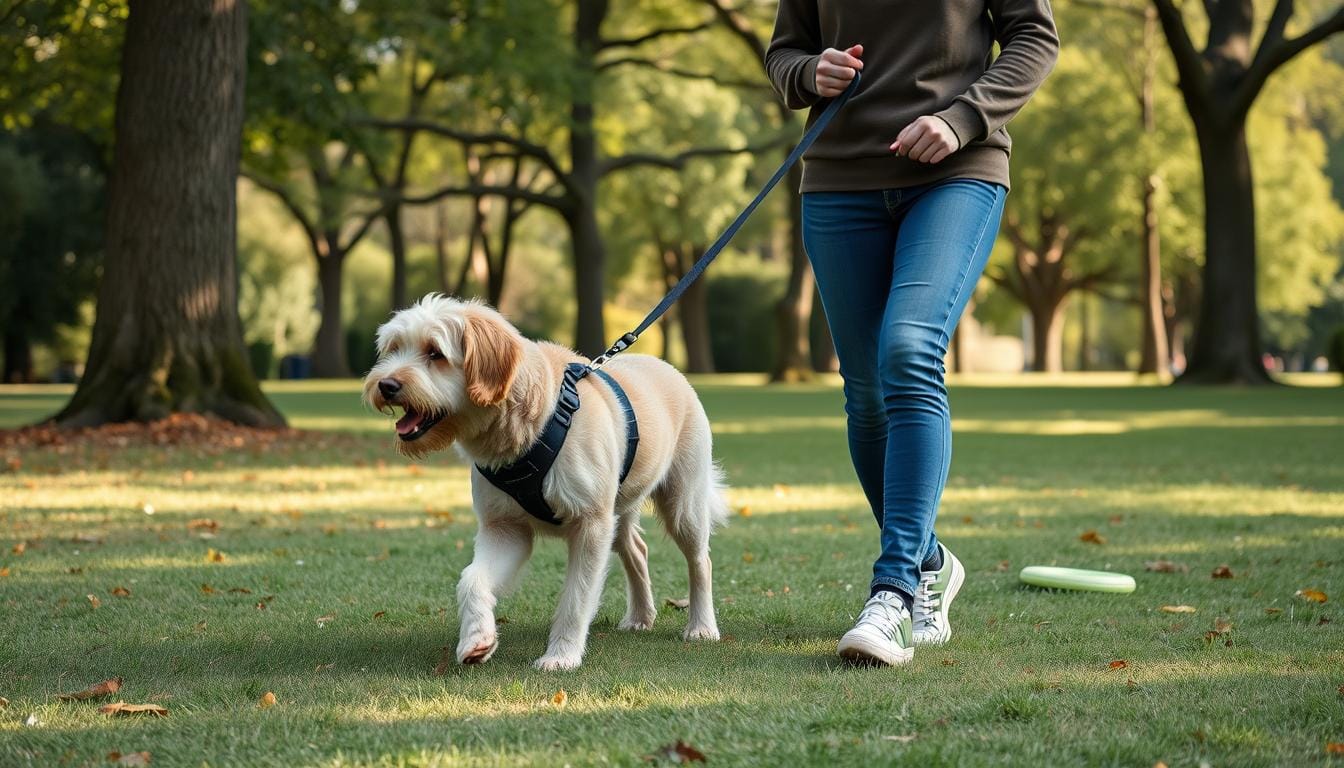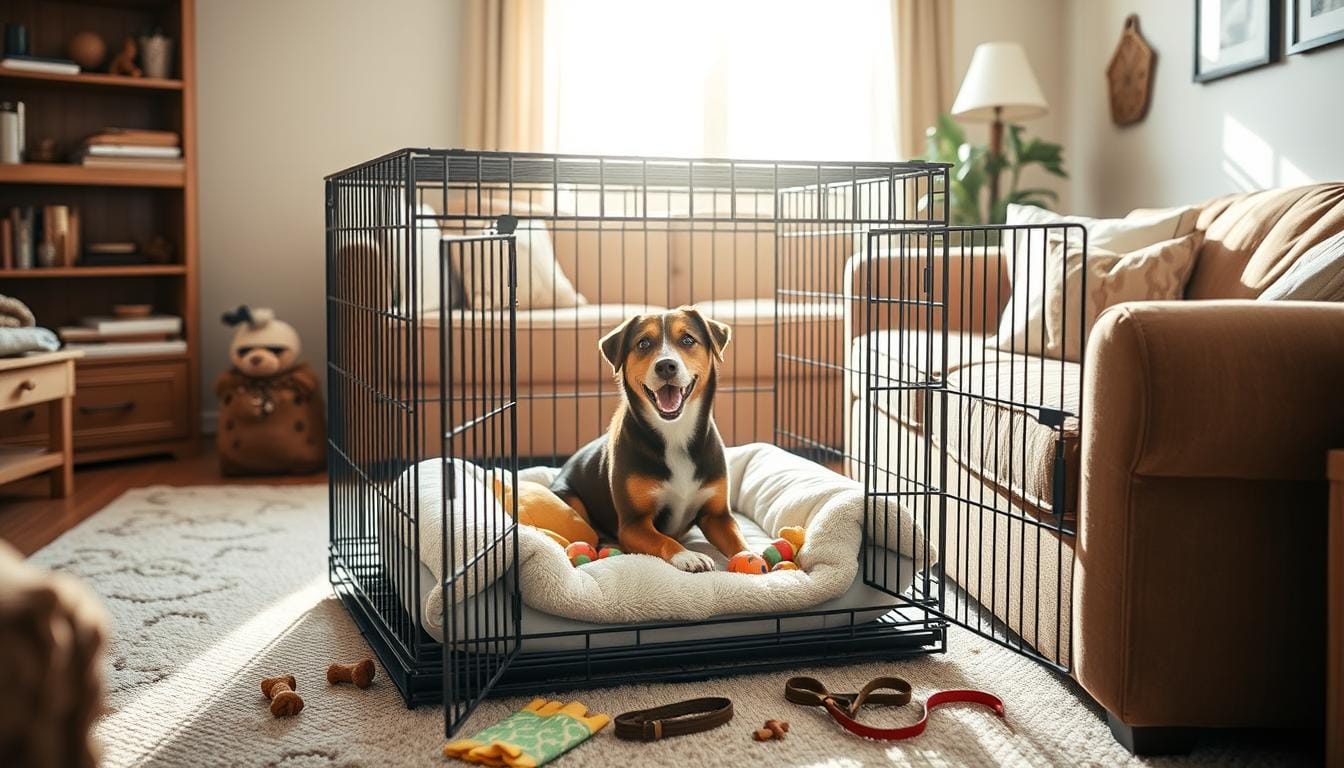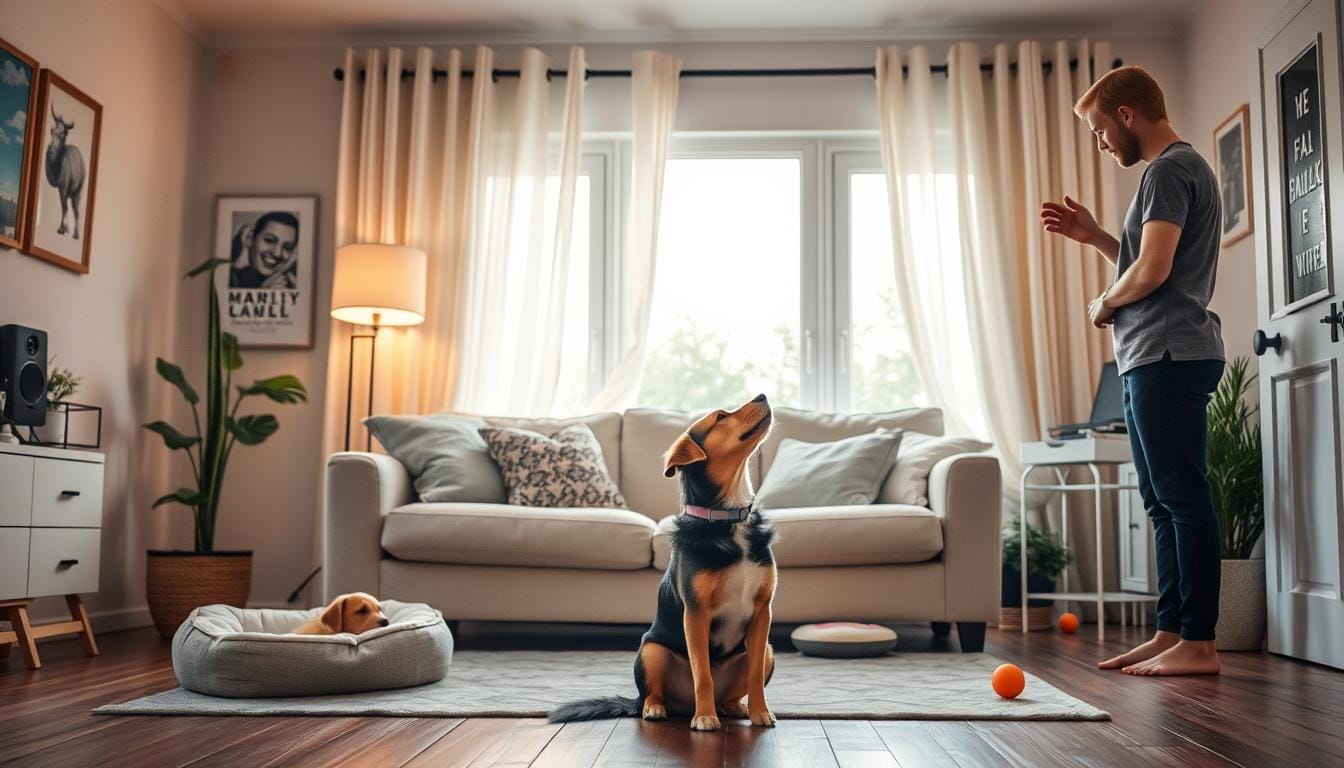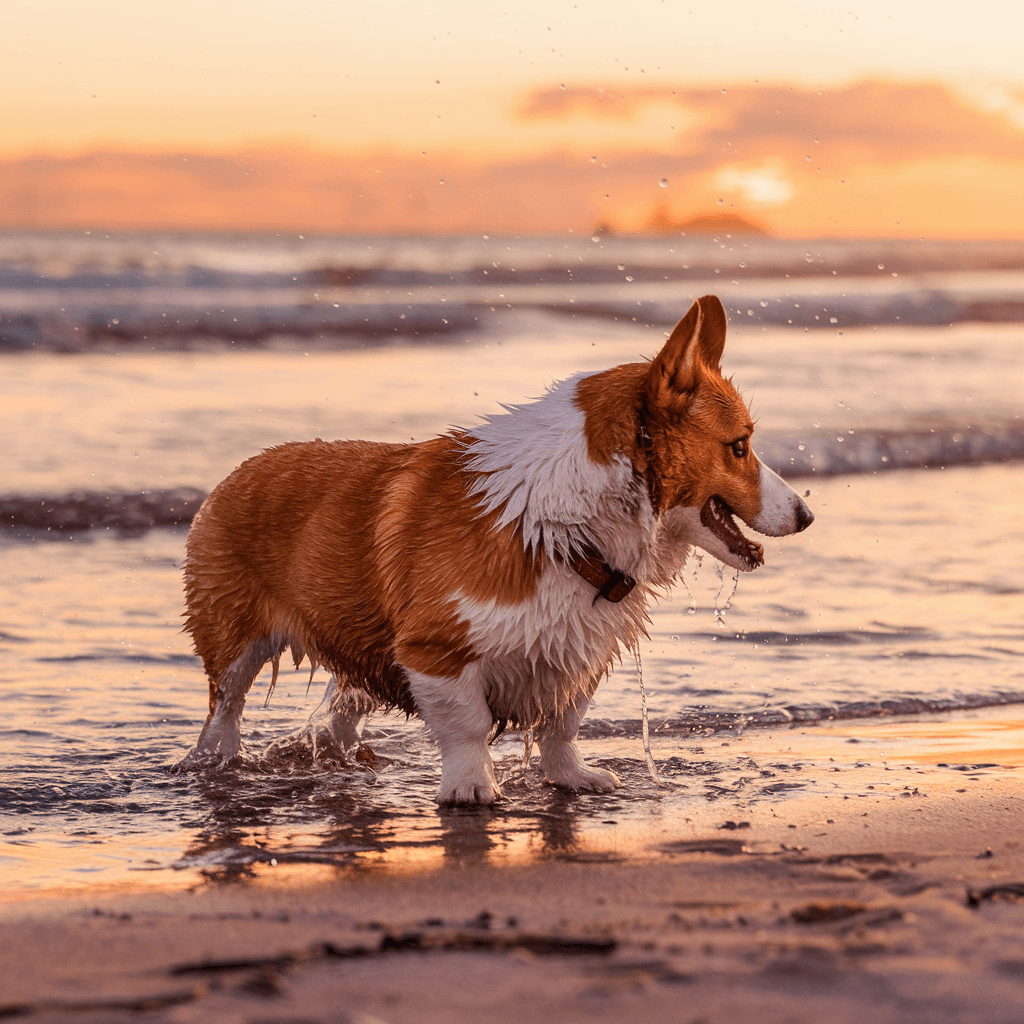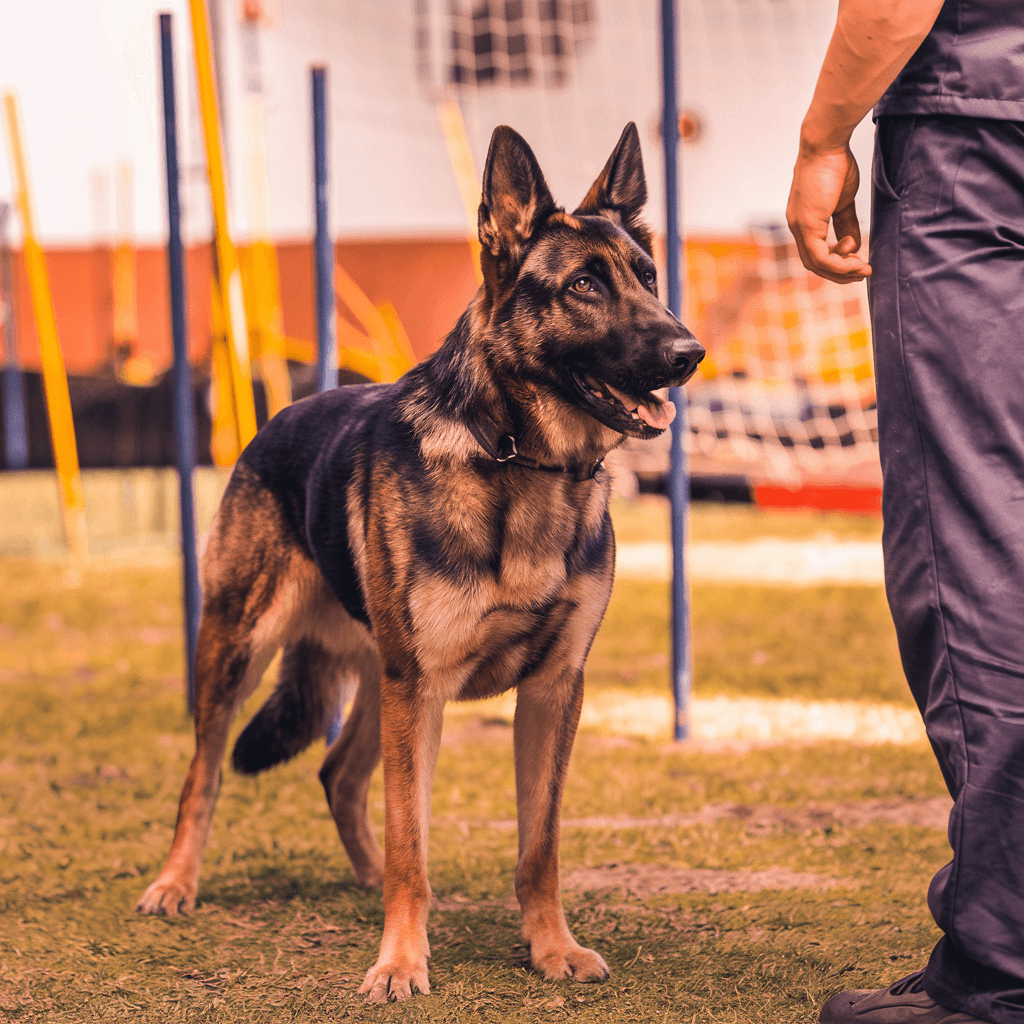Puppies need more than love—they need exercise too! Let’s explore how to keep them active. Puppy exercise is key to raising a healthy, happy dog. We often focus on feeding and training, but exercise is crucial for a puppy’s growth.
Regular dog walking and other exercises help puppies grow strong bones and muscles. It’s not just about physical health, though. Active dogs tend to be better behaved and less prone to destructive habits. Exercise also boosts their mental well-being.
Obesity in dogs is on the rise. Just like in humans, a sedentary lifestyle can lead to weight gain and health problems. By starting a good exercise routine early, we set our puppies up for a lifetime of better health.
But it’s not as simple as taking your puppy for long runs. Growing bones need special care. Short bursts of play are often better than extended periods of intense activity. We need to tailor the exercise to the puppy’s age, breed, and individual needs.
Key Takeaways
- Regular exercise promotes proper growth and maintains a healthy weight in puppies
- Active dogs show better behavior and reduced stress levels
- Exercise needs vary based on a puppy’s age, breed, and individual requirements
- Short, frequent play sessions are often better for puppies than long, intense workouts
- Consistent daily exercise is more beneficial than infrequent, lengthy sessions
- Proper exercise helps prevent obesity and related health issues in dogs
Understanding the Fundamentals of Puppy Exercise, Active Dogs, Pet Health Benefits
Regular exercise is key for puppies and dogs of all ages. It’s not just about burning energy. It’s about healthy growth, preventing obesity, and overall wellness. Let’s explore the basics of pet exercise routines and their benefits for our furry friends.
Physical Development and Growth Stages
Puppies grow fast, needing special attention to exercise. Energetic breeds like Labrador Retrievers and Collies need more activity. But, it’s crucial to match doggy playtime to their age and size.
A good rule is 5 minutes of exercise per month of age, twice a day.
Age-Appropriate Exercise Guidelines
As puppies grow, their exercise needs change. Here’s a quick guide:
- 8-16 weeks: Short play sessions, gentle walks
- 4-6 months: Longer walks, interactive games
- 6-12 months: More intense activities, breed-specific exercises
- Adult dogs: 30 minutes to 2 hours of daily activity
Impact on Overall Health and Wellness
Regular exercise brings many benefits for puppies and adult dogs:
- Improves cardiovascular health
- Aids in muscle development
- Supports weight management and obesity prevention
- Reduces destructive behaviors
- Enhances mental stimulation
By adding varied activities to pet exercise routines, we help our puppies grow into healthy adult dogs. Remember, every pup is unique. Always talk to your vet to create the best exercise plan for your furry friend.
Starting with Basic Leash Training
Leash training is key for dog walking and pet exercise. We start by slowly introducing the leash or harness to our puppy. This helps them feel confident and positive about the equipment.
Training sessions should be short, lasting 5-10 minutes. We use treats to teach them to walk beside us. It’s important to be patient, as some puppies may need more time to get used to the leash.
Good leash training is essential for future dog fitness activities. We must be consistent in our training. As puppies grow, we can make our walks longer and more challenging.
Leash training is more than just physical exercise. It’s also a chance for mental stimulation and bonding. By adding this to our pet routines, we prepare our dogs for a healthy, well-behaved life.
“Leash training is the first step towards a lifetime of enjoyable walks and outdoor adventures with your furry friend.”
With patience and positive reinforcement, leash training can be fun for both us and our puppies. This early effort in training greatly benefits our dog’s health and behavior for years to come.
The Right Amount of Exercise Based on Age
Puppy exercise needs change as they grow. Active dogs need regular physical activity for their health. Let’s look at how to adjust exercise routines for your puppy’s age and development.
Exercise Duration for Different Growth Phases
A good rule for puppy exercise is 5 minutes per month of age, twice a day. For example, a 3-month-old puppy might need 15-minute sessions. As puppies grow, their exercise needs change:
- 2-4 months: Short play sessions, gentle walks
- 4-6 months: Longer walks, basic training exercises
- 6-12 months: More intense activities, longer durations
- 12+ months: Full exercise routines based on breed
Signs of Exercise Fatigue in Puppies
Watch for these signs that your puppy needs rest:
- Lagging behind during walks
- Excessive panting or drooling
- Lying down or refusing to move
- Limping or favoring a leg
Recovery Time Between Activities
Puppies need plenty of rest between exercise sessions. Give them at least an hour of downtime after each activity. This rest is key for muscle growth and avoiding overexertion in young dogs.
Remember, every puppy is different. Adjust their exercise routines based on their energy and health. Talk to your vet to create a plan that boosts your puppy’s health through exercise.
Breed-Specific Exercise Requirements
Dogs vary in their energy levels. Energetic breeds like Border Collies and Australian Shepherds need lots of exercise. We must choose activities that fit each dog’s nature and body.
High-energy dogs need lots of activity. Hiking, swimming, or agility training are great. These activities help them use up their energy and avoid bad behavior. But, breeds like Bulldogs need less exercise, with short walks being enough.

| Breed Group | Daily Exercise Needs | Recommended Activities |
|---|---|---|
| Hunting/Working/Herding | 30 min rigorous + 1-2 hours activity | Agility courses, frisbee, swimming |
| Sporting | 1-2 hours | Fetch, jogging, hiking |
| Terriers | 1 hour | Digging games, tug-of-war |
| Toy Breeds | 30 minutes | Indoor games, short walks |
These are just general tips. Always talk to a vet to make the best exercise plan for your dog. Tailoring activities to your dog’s breed keeps them healthy, happy, and fit.
Safe Exercise Environments and Surfaces
Creating a safe space for your puppy’s exercise is vital for their health. We must think about different things when planning pet exercise routines. This ensures they stay active and healthy.
Indoor vs Outdoor Activities
It’s important to mix indoor and outdoor activities for your dog. Indoor spaces are great for teaching commands and doing low-impact exercises. Outdoor areas offer more room for walking and high-energy play.
Weather Considerations
Weather affects outdoor exercises a lot. Hot pavements can hurt your dog’s paws, and cold weather might need extra protection. On rainy days, indoor activities are better to keep up with exercise routines.
Appropriate Exercise Surfaces
Choosing the right surface for your puppy’s activities is crucial. Grass and packed sand are best for young dogs because they’re easy on their joints. Avoid hard surfaces like concrete until their paws are fully grown. Dogs with arthritis do better on smooth surfaces than rough ones.
| Surface Type | Benefits | Considerations |
|---|---|---|
| Grass | Soft on joints, natural environment | Check for hidden hazards |
| Packed Sand | Low-impact, good for paw strength | Avoid hot sand in summer |
| Indoor Mats | Controlled environment, non-slip | Limited space for high-energy activities |
Remember, variety is key in pet exercise routines. Mix up surfaces and places to keep your puppy engaged and challenged. Always watch your dog during exercise and look for signs of tiredness or discomfort.
Mental Stimulation Through Exercise
Exercise is more than just moving for puppies. It’s a way to grow their minds and stay healthy. Let’s see how we can make their brains work harder through fun activities.
Interactive Games and Activities
Doggy playtime is not just for fun. It’s essential for their health. Games like hide-and-seek or tug-of-war keep them busy and joyful. These games challenge their minds, cutting down on boredom and bad behavior.

Problem-Solving Exercises
Puzzle toys are great for mental workouts. They come in different levels, from easy treat dispensers to hard multi-compartment puzzles. These toys help them play alone and get better at solving problems.
Social Interaction Benefits
Playdates and dog park visits are key for puppies’ social skills. Dogs that socialize well are less likely to have behavioral problems. They’re happier, more confident, and better at making friends.
| Activity | Mental Benefit | Physical Benefit |
|---|---|---|
| Hide-and-Seek | Improves problem-solving | Encourages movement |
| Puzzle Toys | Enhances cognitive skills | Promotes dexterity |
| Dog Park Visits | Boosts social skills | Provides exercise |
A mix of physical and mental challenges is crucial for a puppy’s health. By adding these activities, we’re not just keeping them occupied. We’re helping them become well-rounded, happy dogs.
Preventing Exercise-Related Injuries
Puppy exercise is key for their health, but we must be careful to avoid injuries. We focus on safe, age-appropriate activities. These activities help puppies stay fit without harming their growing bodies.
For puppies under three months, we avoid frequent stair use. This helps prevent hip dysplasia in some breeds. As they grow, we increase exercise intensity. We wait until they’re 10-12 months old for long runs.
We keep exercise sessions short and fun. A daily 30-minute walk, hike, or game of fetch is good for most dogs. For puppies, we break this into smaller chunks. This helps them sleep better and feel more refreshed.
“Exercise provides mental stimulation, which can keep pets engaged and prevent boredom and depression.”
We consider breed-specific needs. Overweight dogs and brachycephalic breeds like English Bulldogs need special care to avoid overheating. Swimming and fetch are great low-impact options for these dogs.
| Age | Exercise Duration | Recommended Activities |
|---|---|---|
| 0-3 months | 5-10 minutes, 2-3 times daily | Gentle play, short walks |
| 3-6 months | 15-20 minutes, 2-3 times daily | Longer walks, interactive games |
| 6-12 months | 30 minutes, 2 times daily | Brisk walks, swimming, fetch |
| 12+ months | 30-60 minutes daily | Runs, agility training, dog sports |
By following these guidelines, we ensure our puppies get the most from exercise. Regular activity boosts their mood and overall well-being.
Building a Consistent Exercise Routine
Creating a solid pet exercise routine is key to raising healthy, active dogs. A well-planned schedule keeps puppies fit and happy. It also prevents obesity, which affects nearly 50 million American dogs. Let’s explore how to build an effective routine for your furry friend.
Daily Schedule Planning
Plan short, controlled exercise sessions for your puppy. This approach prevents overexertion and supports healthy growth. Aim for a mix of activities throughout the day:
- Morning walk
- Midday playtime
- Evening training session
- Bedtime calm-down routine
Incorporating Different Activities
Variety is crucial for keeping doggy playtime engaging. Include a range of exercises to stimulate your puppy physically and mentally:
| Activity Type | Examples | Benefits |
|---|---|---|
| Physical Exercise | Walking, fetch, swimming | Cardiovascular health, weight management |
| Mental Stimulation | Puzzle toys, obedience training | Cognitive development, behavior improvement |
| Social Interaction | Dog park visits, playdates | Socialization, confidence building |
Monitoring Progress
Keep track of your puppy’s exercise tolerance and adjust as needed. Watch for signs of fatigue like excessive panting or reluctance to continue playing. Regular vet check-ups can help ensure your pup’s routine supports their growth stages.
“A tired dog is a good dog. Exercise not only keeps your puppy fit but also helps prevent behavioral issues.”
Remember, consistency is key. Stick to your routine to establish good habits and promote overall well-being in your growing pup.
Exercise’s Role in Behavior Management
Regular puppy exercise is key for managing behavior. Dogs that get to move around are calmer and less hyper. This is because they have lower cortisol levels, which helps reduce stress.
Not enough exercise can cause bad behavior. Bored puppies might dig or chew to get rid of energy. Daily physical activities help cut down on these issues and boost pet health.
Mental games during exercise are also crucial. Puzzle-solving keeps puppies focused and less likely to develop bad habits. This mix of physical and mental activities is great for managing behavior.
“A tired puppy is a well-behaved puppy.”
Playgroups and socialization help prevent anxiety in puppies. Puppies that go to these sessions learn social skills. This makes them less scared of new things.
Having a regular exercise plan is essential for a puppy’s health and behavior. Mixing up activities like swimming and hiking keeps things interesting. The right amount of exercise varies by breed and energy level.
Conclusion
Regular puppy exercise is key for raising active dogs and improving their health. We’ve seen how the right activities help with physical growth, mental sharpness, and behavior. By choosing the right activities for their age and breed, we help our pets stay healthy for life.
Pets also make us healthier. Studies show they lower our risk of depression, lower blood pressure, and better heart health. Kids who grow up with pets tend to be more social and have fewer allergies. This shows how good it is for both humans and animals to be together.
Starting puppy exercise routines is good for both pets and their owners. Sadly, only about half of U.S. adults get enough exercise. But dog owners are more active, showing how pets can help us stay fit and healthy.

